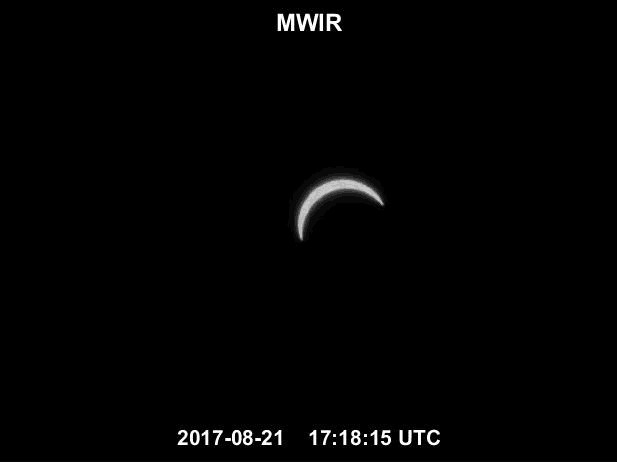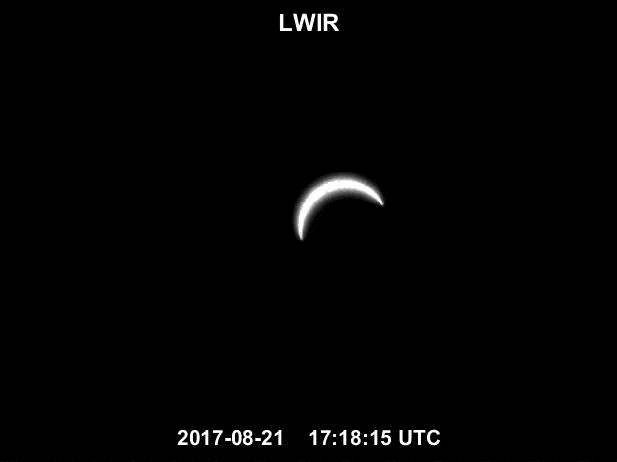
Lincoln Laboratory staff captured first-of-their-kind infrared images of solar eclipse
The sun rose over Weiser, a small community in Idaho close to the Oregon border. In the town's high school, Lincoln Laboratory staff members Jane Luu, Suzannah Riccardi, Justin Baker, and Bert Willard awoke on the dusty gym floor. The team, heeding warnings of a 10-hour traffic jam if they drove to Weiser from their distant hotel in the morning, had decided to camp out in the gym. They weren't taking any chances of missing the solar eclipse the next day, August 21, 2017. They had traveled to this town in the path of totality to take never-before-captured images of the eclipse.
The team — from the Advanced Imager Technology and Active Optical Systems Groups — recorded the eclipse with the Laboratory-developed digital-pixel focal plane array (DFPA) camera. The DFPA camera took images of the eclipse in the mid-wavelength (3–5 μm) and long-wavelength (7–9 μm) infrared.
These first-of-their-kind images hold great scientific potential. Solar astronomers can use the infrared images to further study the Sun's corona, the faint aura of superhot plasma that makes up the Sun's outermost atmosphere. The corona is usually too dim to see next to the brightness of the photosphere; the Moon's blockage of the photosphere during a total solar eclipse offers the best opportunity for observing the corona. In the past, researchers have studied the corona at visible wavelengths from the ground. The mid- and long-wavelength infrared offers strongly reduced sky background compared to the visible.


There's much scientists don't know about the corona, for example, why the corona is hotter than the surface of the Sun even as it extends millions of kilometers away from the Sun. Infrared studies can reveal more about the corona's complex and twisted magnetic fields — perhaps the key to understanding its heat — where energy from the Sun is unleashed in powerful currents that extend far out into space and affect our weather and disrupt our communication systems. The infrared images can also help scientists study the Sun's radius, which is not precisely known, by measuring small dips in light as the Moon and its uneven surface slide past the Sun's face (a phenomenon called the Baily's beads effect).
While eclipses are very well documented, there are very few, if any, observations in the mid- and long-wavelength infrared and no high-cadence, large-dynamic-range images of the Sun at these wavelengths, according to Luu. "The data that we took were not possible before now. This kind of camera, a large-format, robust, high-dynamic-range IR camera, hasn't been around that long."
Lincoln Laboratory has pioneered the development of the DFPA over the past decade, and, more recently, integrated it with a commercial sensor to create the camera. The DFPA is a new generation of focal plane array, which is the device that converts an optical image into an electrical signal that can be read out and processed. In contrast to traditional focal plane arrays, the DFPA implements real-time image processing on chip prior to reading out the data.
"The signal is digitized directly in the pixel," said Baker, one of the DFPA developers. "By doing that, we get tremendous dynamic range and data speed, and can manipulate the images much faster. Essentially, as soon as you capture them."
Dynamic range refers to the range of brightness values a camera can capture, from the lightest light to the darkest dark in a photo. The eclipse presented the perfect test of the DFPA camera's dynamic range, given the stark contrast between bright to dim as the Moon blocks the Sun.
For shooting the eclipse, the team attached the DFPA camera to a telescope and installed it on a tripod outfitted with an equatorial mount. "The mount has two axes that rotate to counteract the rotation of the Earth and keep the Sun centered in the image," said Willard, the team's optical engineer.
Staring straight at the Sun, the camera captured three hours of footage through all stages of the eclipse. It toggled quickly between imaging in the mid-wavelength infrared and long-wavelength infrared and within those toggles took a series of photos at three different exposures. "If you can capture photons in different bands simultaneously, you can interpolate unique spectral characteristics and extract minute details in the data," Baker said.
All in all, the images add to a trove of new information collected during this historic, America-traversing eclipse. For the Laboratory researchers, it was an adventure. Baker and Riccardi saw their first total solar eclipse. Willard adds this experience to a lifetime of eclipse chasing, starting in 1963 on his honeymoon.
"This was my second time," Luu said. "The first time, I just looked at it. It was a lot more exciting to have a goal. The stakes were a lot higher. We didn't know how the camera was going to operate, or if we would get what we came for," Luu said. "Most cameras can't point directly at the Sun. This one can, and it behaved beautifully."
The next total solar eclipse visible from North America will be in 2024. This one will be closer to home, as its path will cut across northern New England. By then, new technology could once again give us a greater perspective, and deeper understanding, of the heart of our solar system.

